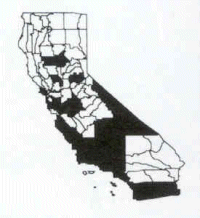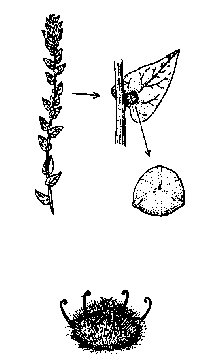|
Bassia hyssopifolia
|
|
|
|
Scientific name
|
Bassia hyssopifolia
|
|
Additional name information:
|
(Pallas) Kuntze
|
|
Common name
|
bassia, five-hook bassia, thorn orache, five-horn smotherweed
|
|
Synonymous scientific names
|
Echinopsilon hyssopifolia, Salsola hyssopifolia
|
|
Closely related California natives
|
0
|
|
Closely related California non-natives:
|
0
|
|
Listed
|
CalEPPC List B,CDFA nl
|
|
By:
|
Guy Kyser,Marc C. Hoshovsky
|
|
Distribution
|
|
HOW DO I RECOGNIZE IT?
Distinctive features:
|
Bassia (Bassia hyssopifolia) is a
grayish annual up to three and one third feet tall; with inconspicuous flowers
and younger stems that are densely covered with long, soft, straight hairs.
Branches angle out at thirty to sixty degrees from the stem. The small fruit has
five distinctive hooked structures on each seed, looking and adhering like a
five-legged tick. Overall, this plant looks similar to lambs’ quarters
(Chenopodium album), but it has smaller, elongated, pointed leaves.
Bassia is sometimes confused with other members of the Chenopodiaceae, such as
Russian thistle (Salsola tragus) or kochia (generally Kochia
scoparia). Russian thistle is more profusely branched and spiny than bassia
(Fischer et al. 1979). Bassia more closely resembles plants of the genus
Kochia, within which some taxonomists believe it should be included
(Hickman 1993). Bassia is hairier than kochia, produces a pronounced,
woolly-looking flowering spike unlike kochia’s small clusters of flowers, and
has a characteristic five-spined fruit.
|
|
Description:
|
Chenopodiaceae. Leaves: linear to
lanceolate; largest leaves, found toward base of plant, are 1.6-2.4 in (40-60
mm) long, 0.04-0.14 in (1-3.5 mm) wide, flat, untoothed, and alternate. Bassia
flowers between July and October. Inflorescence: spike 0.2-2 in (5-50 mm) long,
with oblong, leaf-like bracts 0.08-0.2 in (2-5 mm) long that often wither in
fruit. Flowers: tiny, without petals, in axillary groups of one to a few; 5
stamens and 2 or 3 stigmas. Calyx is tan, densely woolly, becoming leathery;
attached to the calyx are 5 incurved, hooked spines about 0.04 in (1 mm) long.
Fruit: including the persistent calyx, is 0.04-0.06 in (1-1.5 mm) in diameter,
containing a single dark brown seed about 0.04 in (1 mm) long (Munz and Keck
1973, Hickman 1993). |
|
|
|
WHERE WOULD I FIND IT?
|
Hickman (1993) reports that bassia occurs widely in California,
except in the Klamath and northern Coast Ranges and in the Sierra Nevada above
1,200 meters (about 3,900 ft). It appears to do well on basic or saline soils.
Robbins et al. (1970) report the occurrence of bassia in the “spiny salt bush
association” of the San Joaquin Valley. It is also common in abandoned
agricultural fields in the Owens Valley, the Mojave Desert (Lancaster), the
Colorado (Imperial Valley) Desert, the South Coast (Santa Ana River), and
northward through the Sacramento Valley (Robbins et al. 1970, Sanders, pers.
comm.). It is also known from the Sierran foothills, such as near Mount Lassen
in the north and Lake Isabella (Kern River) in the south (Ahart, pers. comm.,
Hewett, pers. comm.). It may also occur in extreme northern California, near
Tulelake, on the Modoc Plateau.
|
|
WHERE DID IT COME FROM AND HOW IS IT SPREAD?
|
Bassia is native to parts of Europe and Asia, particularly
around the Caspian Sea. It was first recorded in North America near Fallon,
Nevada, about 1915 (Collins and Blackwell 1979). It probably was introduced as a
seed contaminant, possibly with Turkestan alfalfa (Medicago sativa) seed (Alex
1982). It was found as early as 1921 near Los Banos in the San Joaquin Valley.
By 1940 it could be found in spiny saltbush (Atriplex confertifolia) and mixed
lowland associations of the San Joaquin, Owens River, Santa Ana River, Imperial,
Coachella, and Palo Verde valleys (Robbins 1940). It had also spread to
neighboring Arizona and as far as British Columbia and Wyoming, growing well in
soils too alkaline for crops. By this time bassia was also established on the
East Coast, where it has maintained a limited distribution from Maine to New
York City.
Considering the external structure of the fruit, bassia seeds
probably disperse by attaching to the fur or feathers of passing animals
(Collins and Blackwell 1979). Human disturbances, such as road building or ditch
clearing, help to establish bassia and likely contribute to dissemination as
well. The seeds do not survive well in fresh water for extended periods (Bruns
1965).
|
|
WHAT PROBLEMS DOES IT CAUSE?
|
Bassia occasionally may displace native species, but there is no
evidence that it alters other ecosystem processes (e.g., fire cycles,
hydrological cycles, soil chemistry, etc.). On The Nature Conservancy’s Kern
River Preserve, in the southern Sierra, bassia covers five to ten acres (2 to 4
ha) in a multitude of small clusters, becoming a monospecific stand in the
densest areas. Once established, it is somewhat persistent, although it does not
appear to be on the increase at the Kern River Preserve. In some areas native
species are replacing bassia (Hewett, pers. comm.), suggesting that it is
possibly ruderal or stress-tolerant rather than competitive. Because it is toxic
to sheep, bassia can be a threat to livestock (James et al. 1976).
|
|
HOW DOES IT GROW AND REPRODUCE?
|
Bassia is an annual, reproducing by seeds (Muenscher 1955). Its
germination and growth patterns have not been extensively studied (Collins and
Blackwell 1979).
However, the following can be inferred from the plant’s
environmental preferences and from the habits of its close relatives: seed
dormancy is relatively short; germination requires warm, high-light conditions;
germination and seedling growth are not hindered by moderately saline/alkaline
conditions; and initial growth is rapid, especially below ground.
|
(click on photos to view larger image)

bassia-small2
|
|
|
|
|
|
HOW CAN I GET RID OF IT?
|
|
|
Physical control:
|
Mechanical removal: Muenscher (1955) recommends hand
pulling of bassia, done most easily after a rain when soil is loose.
Plants should be pulled as soon as they are large enough to grasp but
before they produce seed. Pieces of root remaining in the soil will not
sprout again. Plants can be destroyed readily while they are still small
by hand hoeing, either by cutting off the tops or by stirring the surface
soil to expose seedlings to drying by the sun.
Prescribed burning: This might be a useful control
strategy for bassia, though it has not been tried. Because bassia produces
flowers and seeds later in the season than do most rangeland plants, there
may be a period in mid-summer during which desirable plants have senesced
and dropped seed but bassia has not. If such a window exists, dry senesced
plants could provide enough fuel to kill bassia before it produces seed.
However, most reported infestations of bassia are sparse and limited in
extent, so that presence of this weed alone may not justify
burning.
|
|
Biological control:
|
Insects and fungi: The only mention of
insect herbivory in the literature is of Lygus sp. leafhoppers feeding on bassia
in late summer (Parker 1972). The degree to which these insects affect the
growth of bassia was not reported. No program currently exists for biological
control of bassia.
Grazing: Livestock readily graze on bassia,
although sheep have died after a single feeding (James et al. 1976). Goats have
not yet been used to control bassia.
Plant competition: Experience at the Kern River Preserve suggests that
minimizing disturbance in non-crop settings may allow more desirable plants to
outcompete and replace this weed.
|
|
Chemical control:
|
Chemical control of bassia has not been
reported, although it might be similar to control of other similar species, such
as kochia and Russian thistle. Kochia and Russian thistle are well controlled by
metsulfuron, triasulfuron, thifensulfuron + tribenuron, or tribenuron at
label-recommended concentrations. Herbicide-resistant populations of kochia are
known to arise, and this can be minimized by tank-mixing these sulfonylurea
herbicides with other broadleaf herbicides with differing modes of action.
Russian thistle can also be controlled with dicamba, 2,4-D, and
picloram plus 2,4-D at 1-1.5 fl oz/acre + 0.75 pt/acre. Kochia can also be
controlled with dicamba plus MCPA amine at label strengths. 2,4-D at 1.0 pt/acre
gives good kochia control, but good spray coverage is essential because 2,4-D
does not translocate readily in kochia. Treatment should be to small plants
(less than three inches tall), or large spray volumes should be used to
penetrate the kochia foliage. The esters of 2,4-D generally are more effective
than the amines for both weeds. MCPA is not as effective as 2,4-D in controlling
either weed. However, MCPA at 1.0 pt/acre will control small kochia plants.
Picloram is not effective on kochia; but control is good when it is combined
with 2,4-D ester at 0.75 pt/acre (North Dakota State University Extension
Service 1998). Because bassia infestations occur in non-agricultural areas and
tend to be limited in scope, spot spraying (not broadcast) is the preferred
method of herbicide application in most cases. Check herbicide labels for
current registered uses in California.
|




